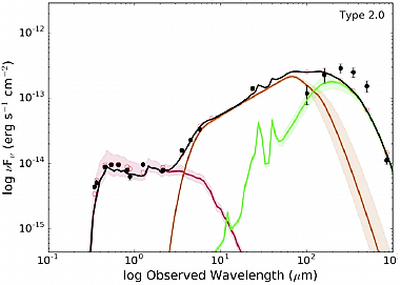The early black-hole growth in highly star forming, dust-enshrouded galaxies
What is the link between (high) star formation and (early) black hole growth, and what is the role of orientation in deeply buried AGN?
The focus of this Work Package is to characterize the phases of potentially super-EddingtonM, i.e. rapidly accreting, (early?) black holes using panchromatic AGN within the IR/submm phase.

Task 1A: The accretion and host star formation rate of rapidly accreting black holes
In the X-rays, we have direct access to the deepest Chandra surveys, the most recent wide-area XMM surveys, and the latest very hard energy (>10keV) NuSTAR data. In the IR, we will combine Herschel, AllWISE, ALMA, Scuba-2, with CANDELS, COSMOS, GOODS. Accurate multiwavelength spectral energy distribution (SED) fitting via diverse AGN and galaxy templates (diagram above) will make use of state-of-the-art Bayesian and Deep-Learning techniques to infer AGN accretion down to the most heavily obscured AGN and measure (specific) star formation rates. We will ultimately determine the still unclear relation between early black hole growth and host galaxy star formation rate, their relative timescales and AGN “duty cycles”.
Task 1B: Probing the role of orientation in buried AGN
A surrounding small scale “dusty torus” may fit some AGN SEDs (diagram above) but is it common in early black holes? To answer this, from the SED we will first compute host extinction and star formation. From X-ray data we will then infer line-of-sight column densities via state-of-the-art X-ray-photon transmissions Monte Carlo simulations. An increasing NH with star formation rate can validate the evolutionary model in which “Compton-thick”/very-obscured AGN live in the most star-forming systems.

